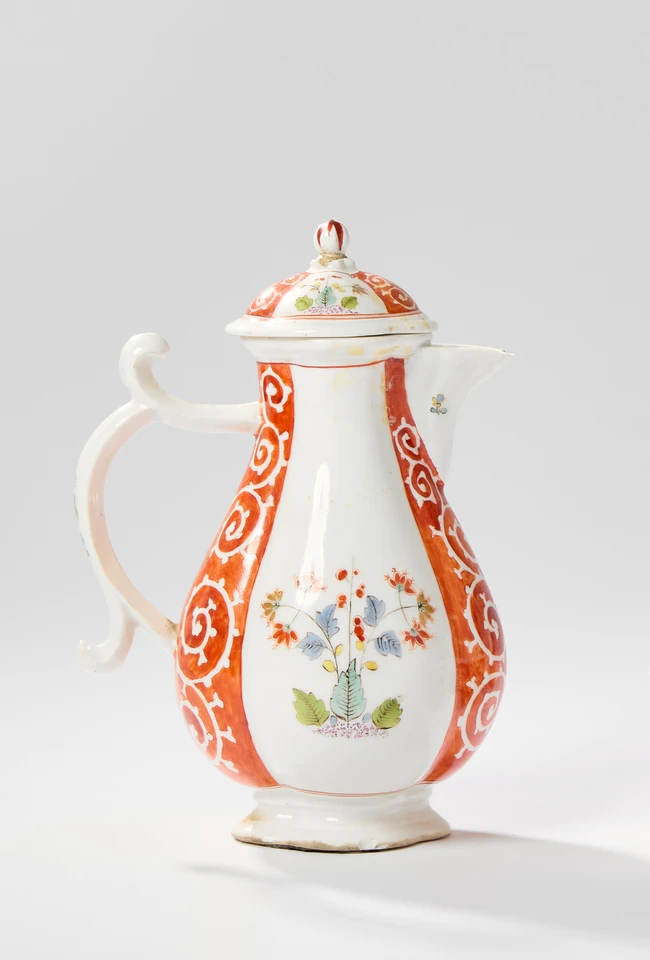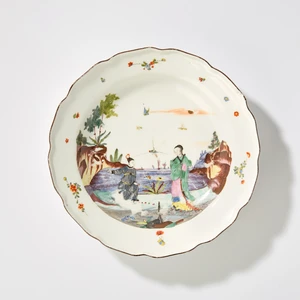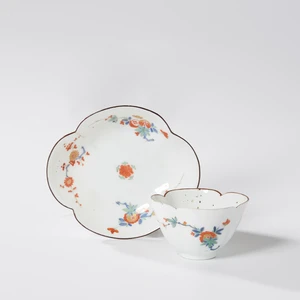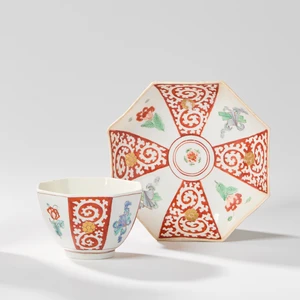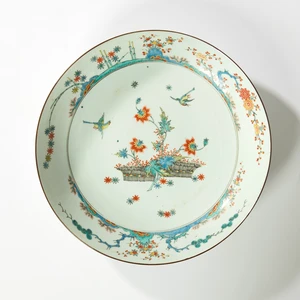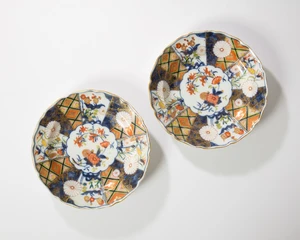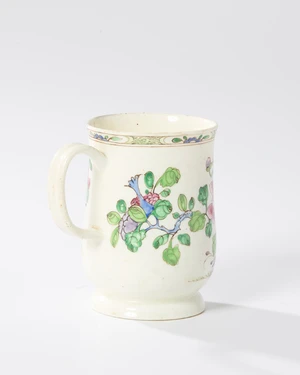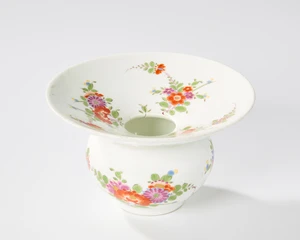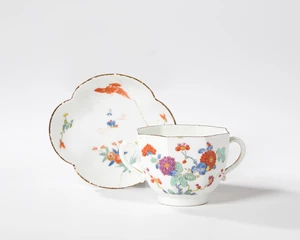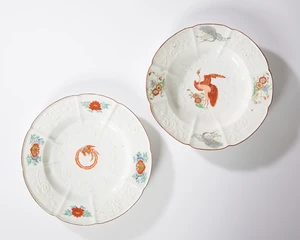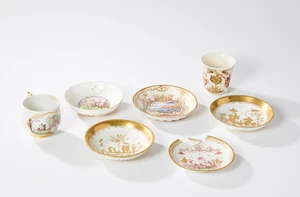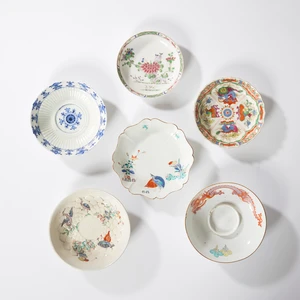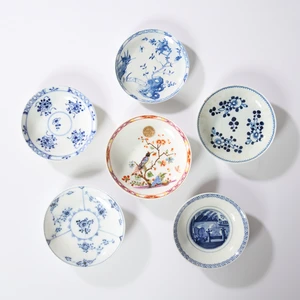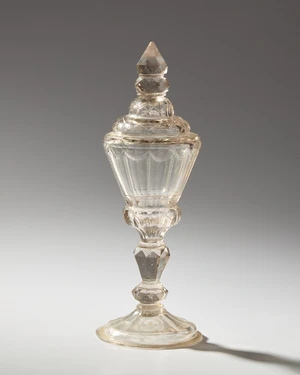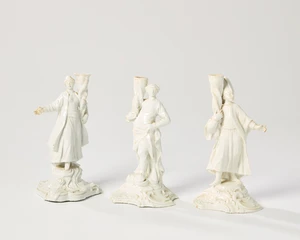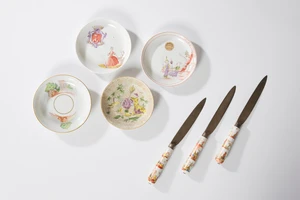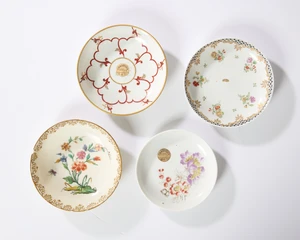Tuesday 11 March 2025
Property of the Late Hugo Morley-Fletcher MA FSA (1940-2022) (lots 1-64)The following 64 lots...
View MoreLot 1
Description
Property of the Late Hugo Morley-Fletcher MA FSA (1940-2022) (lots 1-64)
The following 64 lots belonged to the late Hugo Morley-Fletcher, the great European Ceramics specialist who worked at Christie’s for over 40 years and appeared on the BBC’s Antiques Roadshow for over 25 years.
Hugo was born in 1940 and spent the Second World War in his mother’s family’s ancestral home, Yester House near Edinburgh. Yester was built between 1699 and 1728 for the Marquesses of Tweeddale. In 1729 the 4th Marquess commissioned William Adam to carry out alterations, particularly to the interiors, but William died before the work was completed, and it wasn’t until his sons Robert and John Adam resumed work on it in 1759 that it was completed in the early 1760s. Yester is one of Scotland’s finest houses and its architecture, plasterwork and contents had a profound impact upon Hugo. His mother was also a talented sculptor, so art was in his blood. Shortly after his grandfather the 11th Marquess died in the late 1960s, the house was sold, along with a lot of the contents. The first fourteen lots in Roseberys’ Old Master, British & European Pictures sale on 12th March once hung on the walls at Yester and depict Hugo’s ancestors, amongst other subjects.
Hugo had his own rather eccentric aristocratic style and sense of panache in tandem with an unerring confidence; this was off-putting to some, but utterly captivating to others. Working with Hugo at Christie’s was, at times, a little challenging, but it was certainly never dull. He loved wearing his green loden cape that he had bought in Vienna, yet paradoxically, Hugo always retained his sense of Britishness. On one occasion, over 20 years ago, when we were in a tiny railway station in the middle of nowhere in Germany, we were struggling to get a ticket machine to work when a local kindly intervened to help. He then asked if we had been there the previous year. When we confirmed that we had, and asked why he asked, he replied that he remembered Hugo’s red socks!
Hugo had a natural eye for art, frequently cutting straight to the key points of an object. His understanding extended beyond ceramics to encompass pictures and other decorative arts, and he had the ability to identify the best artwork in a room filled with things, whether it was ceramic or something different. He had a prodigious memory, priding himself in his ability to memorise the position of objects within a client’s house and retain that memory many years after the visit. He also had the ability to give a summary value of a collection after only the briefest of visits. He was often generous with his knowledge, but on other occasions would withhold it as a test. The study groups of saucers and small objects in this sale illustrate some of the fascinating complexities found in ceramics, and they would be an excellent vehicle for teaching.
Hugo was a fine linguist and was completely untroubled by taking auctions in a variety of different languages. He also had a natural curiosity and understanding of other cultures, and Continental friends and clients were frequently surprised and impressed by his knowledge of both their history and current affairs, which often surpassed their own. His almost encyclopaedic knowledge of Royal and aristocratic families in Britain and the Continent meant that he understood how these families and historical events shaped the creation of ceramics of time, and as he once reminded me, with the creation of ceramics, ‘there is always someone writing a cheque’.
Hugo was a tour-de-force in the ceramics world, publishing a number of specialist books included Investing in English Pottery and Porcelain (1968), Meissen (1970), Meissen in Colour (1971) and the Pflueger collection of Early European Porcelain and Faience (1994) and was also was also one of the founding member of the French Porcelain Society. When he joined Christie’s in 1963 the market was dominated by Sotheby’s under the auspices of the great Tim Clarke. By the 1970s Hugo had reversed this. Two of the iconic sales of the 1970s were a highly important collection which was sold anonymously in March and October 1977, making a huge amount of money at the time. These were followed by many others.
Later in his life Hugo became Prime Warden of the Worshipful Company of Dyers in the City of London which ushered in his charitable work with the Boucher Church of England Primary School, a disadvantaged school in East London. Hugo gave lessons in French and Latin, and in particular he was keen to promote reading, instigating the practice of the Dyers to donate a book to every pupil of the school each year.
Text courtesy of Dominic Simpson, Consultant and former Head of European Ceramics at Christie’s.
A Meissen porcelain Kakiemon baluster small coffee-pot or hot-water jug and cover, c.1735, blue crossed swords mark, Dreher’s incised cross and impressed four dots mark, of quatrefoil section, the triple-scroll lozenge-section handle with a projecting scroll thumbpiece, two panels of the body painted with flowering shrubs enriched in gilding, alternating with iron-red panels reserved with white scrolls centred by gilt flowerheads, on a short stepped quatrefoil foot, the domed quatrefoil cover similarly decorated, 19cm high
Provenance:
Dr Marcel and Frau Nyffeler Collection sale; Christie’s, London, 9 June 1986, lot 148.
Property of the late Hugo Morley-Fletcher MA FSA (1940-2022).
Note: This unusual design is a variant of a slightly earlier design of a few years earlier, referred to in the footnote to the Chelsea tea bowl and saucer decorated with a related design.
Fees & VAT
Buyer's Premium
The buyer shall pay the hammer price together with a premium thereon of 26% up to £20,000 (31.2% inclusive of VAT), 25% from £20,001 - £500,000 (30% inclusive of VAT), 20% from £500,001 thereafter (24% inclusive of VAT). The premium price is subject to VAT at the standard rate.
VAT
VAT is not charged on the hammer price unless it is stated that there is 'VAT applicable on the hammer price at the end of the description. Buyer's premium is subject to VAT.(ARR) - ARTIST'S RESALE RIGHT
Qualifying living artists and the descendants of artists deceased within the last 70 years are entitled to receive a re-sale royalty each time their work is bought through an auction house or art market professional.
It applies to lots with hammer value over £1,000 as follows:
0 to £50,000 - 4%
£50,000.01 to £200,000 - 3%
£200,000.01 to £350,000 - 1%
£350,000.01 to £500,000 - 0.5%
Exceeding £500,000 - 0.25%
ARR is capped at £12,500
Please note ARR is calculated in euros. Auctioneers will apply current exchange rates.
Export of goods
Buyers intending to export goods should ascertain whether an export licence is required before bidding. Export licences are issued by Arts Council England and application forms can be obtained from its Export Licensing Unit. Details can be found on the ACE website www.artscouncil.org.uk or by phoning ACE on 020 7973 5188. The need for import licences varies from country to country and you should acquaint yourself with all relevant local requirements and provisions before bidding. The refusal of any such licences shall not permit the cancelling of any sale nor allow any delay in making full payment for the lot.
Own a similar item?
Request a ValuationReceive alerts about similar lots
Get StartedContinue Browsing
LOT 2
A Meissen porcelain lobed dessert-plate of Earl of Jersey type, c.1735, blue crossed swords...
Estimate: £1500 - £2000
LOT 3
A Meissen porcelain Kakiemon quatrefoil tea bowl and a quatrefoil saucer, c.1730-35, blue...
Estimate: £400 - £600
LOT 4
A Chelsea porcelain Kakiemon tea bowl and a saucer, c.1750-52, four panels of the tea bowl...
Estimate: £180 - £250
LOT 5
A Chinese porcelain Dutch-decorated dish, Kangxi period (1662-1722), the Dutch decoration first...
Estimate: £150 - £200
LOT 6
Two Continental porcelain lobed plates, possibly Samson, late 19th century, pseudo-Chelsea...
Estimate: £400 - £600
LOT 7
A Bow porcelain mug, c.1755, of slight baluster form with a channelled loop handle, painted in a...
Estimate: £180 - £250
LOT 8
A Meissen porcelain Kakiemon spittoon (spucknapf), c.1730-35, blue crossed swords mark, with a...
Estimate: £800 - £1200
LOT 9
A Meissen porcelain Kakiemon two-handled octagonal cup and a quatrefoil saucer, c.1730-35, blue...
Estimate: £200 - £300
LOT 10
A Chelsea porcelain Kakiemon plate and a Chelsea porcelain Kakiemon soup plate, c.1755, red...
Estimate: £300 - £500
LOT 11
A study group of two Böttger porcelain Hausmalerei saucers, two Meissen Hausmalerei saucers, a...
Estimate: £300 - £500
LOT 12
A study group of four French porcelain saucers and two English porcelain saucers, comprising: a...
Estimate: £250 - £400
LOT 13
A study group of four Continental porcelain and two English porcelain saucers, 18th century,...
Estimate: £200 - £300
LOT 14
A German glass vase, mid-18th century, the dodecagonal tapering body above a cut knopped stem...
Estimate: £250 - £400
LOT 15
Three Doccia porcelain white figural candlesticks, c.1765, with two turbaned figures and another...
Estimate: £1500 - £2000
LOT 16
A study group of three Italian porcelain cutlery-handles, three Samson porcelain saucers and a...
Estimate: £150 - £250
LOT 17
A study group of a Capodimonte porcelain saucer and three Samson saucers, comprising: a...
Estimate: £100 - £150
 Newsletter Signup
Newsletter Signup
 Keyword Alerts
Keyword Alerts
Would you like to receive personalised keyword alerts when new catalogues go live. If so, please indicate these below
Set a password to save your keyword alerts
Passwords are a minimum of 7 characters and must include an upper case letter, a lower case letter, a number and a special character (e.g., !@#$%^&*).


